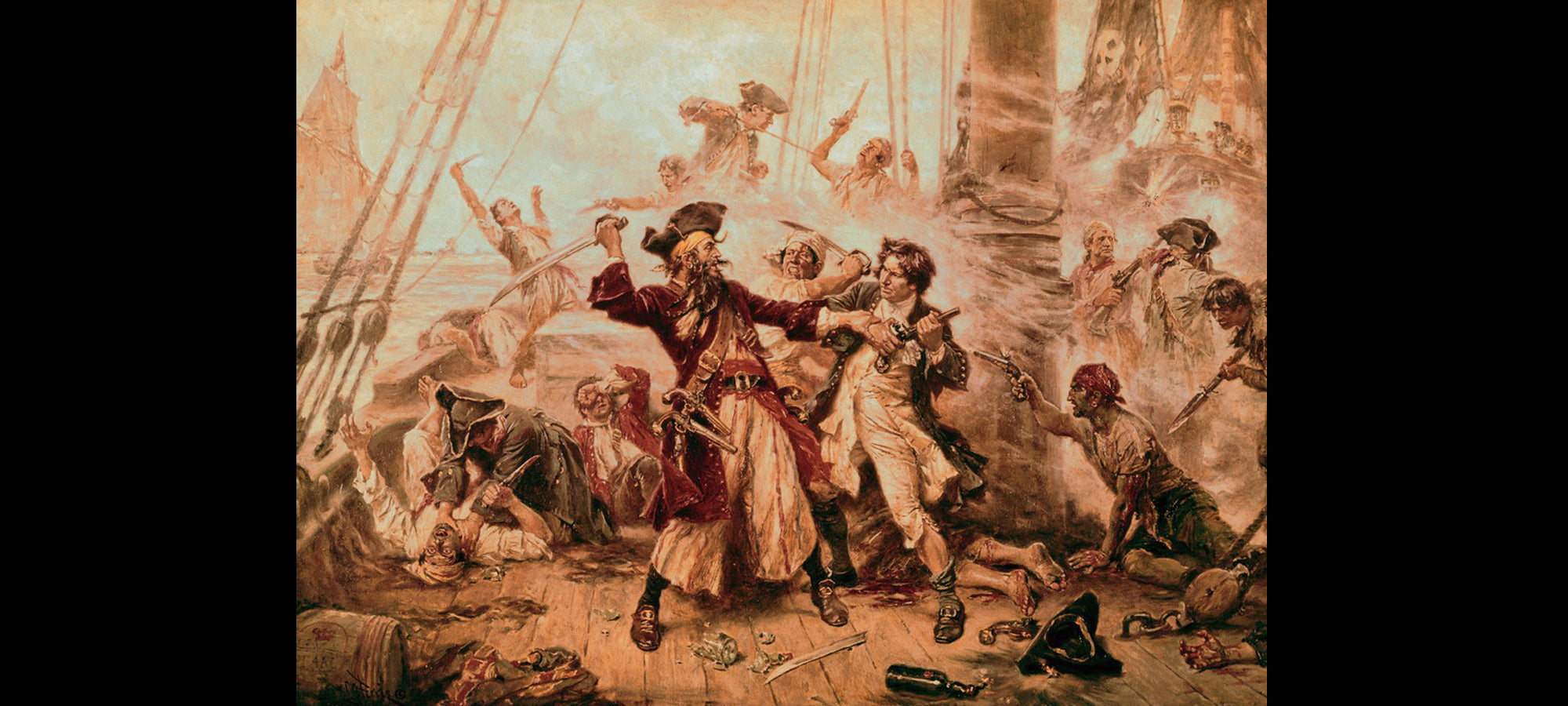
History's Most Infamous Pirates
Join us in celebrating the life and times of the most infamous pirate swashbucklers ever to sail the seven seas.
 Calico Jack
Calico Jack
Known for his distinctively colorful attire and cunning escapades, Calico Jack terrorized the Caribbean during the early 18th century. Born John Rackham in England around 1682, little is known about Calico Jack’s early life, but by the early 18th century, he had ventured to the Caribbean, where he began his foray into piracy. Initially, Rackham served under the pirate Charles Vane, who commanded a ship called the Ranger. In 1718, Rackham led a mutiny against Vane and took command of the vessel, giving rise to Calico Jack, the pirate captain.
Colorful and Cunning
The late 17th and early 18th centuries were marred by war on land and sea, both in Europe and the New World, and Calico Jack proved to be a formidable opportunist and strategist, capitalizing on the chaos of the era. He employed guile and cunning to seize merchant ships and amass wealth, earning his nickname "Calico Jack" thanks to his penchant for wearing colorful calico cotton clothing.
One of Calico Jack's most significant contributions to pirate lore was his adoption of the Jolly Roger flag, featuring a skull and crossed swords. This emblem struck terror into the hearts of sailors and became synonymous with piracy.
Anne Bonny and Mary Read
Calico Jack's crew was notable for including two fierce female pirates, Anne Bonny and Mary Read. Anne Bonny, the daughter of a wealthy plantation owner, abandoned her privileged life to join Calico Jack's crew. Mary Read, on the other hand, had spent much of her life disguised as a man, working aboard merchant vessels and in the British military before turning to piracy.
Both women proved to be skilled fighters and sailors, earning the respect of their crewmates and contributing to Calico Jack's notoriety. Their presence on his crew shattered societal expectations of the time and added to the legend of Calico Jack.
Downfall and Execution
Calico Jack's piracy career was relatively short-lived. In October 1720, Rackham's ship was captured off the coast of Jamaica by a British naval vessel, the Tyger, commanded by Captain Jonathan Barnet. The pirate crew, caught off-guard and heavily intoxicated, put up little resistance, and Rackham and his crew were quickly arrested.
Calico Jack was tried and convicted of piracy and subsequently hanged in Port Royal, Jamaica, on November 18, 1720. His body was left to rot in a gibbet at the entrance of the harbor as a warning to other pirates. Although his reign was brief, Calico Jack’s impact on the world of piracy and popular culture endures. His adoption of the Jolly Roger flag, his association with Anne Bonny and Mary Read, and his daring exploits have made him an iconic figure in pirate lore.
 Blackbeard
Blackbeard
Operating in the West Indies and along the eastern coast of the American colonies, Blackbeard's fearsome reputation and cunning tactics made him a legendary figure. According to records held by the Royal Greenwich Museum, Edward Teach was born around 1680, likely in Bristol, England. Although little is known about his early life, Teach ventured to the Caribbean during the War of the Spanish Succession (1701-1714), where he served as a privateer. Following the war's end, Teach, like many privateers, turned to piracy for continued employment and wealth. He joined the crew of the pirate Benjamin Hornigold in 1716, quickly establishing himself as a skilled and ruthless pirate.
The Rise of Blackbeard
In 1717, Hornigold awarded Teach command of a captured ship, which he renamed the Queen Anne's Revenge. Teach soon adopted the moniker "Blackbeard," a name derived from his thick black beard and fearsome appearance. Blackbeard cultivated his terrifying image by tying slow-burning fuses into his beard, creating a hellish visage as he boarded enemy ships.
Blackbeard's reputation grew as he terrorized merchant vessels throughout the Caribbean and the American colonies. His tactics included flying a flag depicting a skeleton stabbing a heart, striking fear into his enemies, often causing them to surrender without a fight.
The Blockade of Charleston
One of Blackbeard's most audacious exploits was the 1718 blockade of Charleston, South Carolina. Blackbeard's fleet captured several merchant ships entering and exiting the port, effectively cutting off the city's trade. He demanded a ransom of medical supplies for the release of his hostages, showcasing his cunning and strategic mind. The successful blockade further solidified Blackbeard's reputation as a ruthless and formidable pirate.
Pardon and Betrayal
In 1718, Blackbeard took advantage of a royal pardon offered to pirates by the British government. He settled in Bath, North Carolina, ostensibly to live as a law-abiding citizen. However, Blackbeard soon returned to piracy, operating under the protection of corrupt colonial officials. This betrayal of the pardon would contribute to his eventual downfall.
Downfall and Death
Blackbeard's return to piracy prompted Virginia Governor Alexander Spotswood to take action. In November 1718, he dispatched a naval force led by Lieutenant Robert Maynard to hunt down and capture the notorious pirate. On November 22, Maynard's forces engaged Blackbeard and his crew in a fierce battle at Ocracoke Island, off the coast of North Carolina.
Blackbeard fought ferociously but ultimately succumbed to his injuries, which included five gunshot wounds and over twenty sword cuts. Maynard beheaded Blackbeard and hung his head from the bowsprit of his ship as proof of the pirate's demise. Blackbeard's life and times epitomize the brutality and lawlessness of the Golden Age of Piracy. His fearsome reputation, cunning tactics, and relentless pursuit of wealth made him a legendary figure whose name still evokes terror and fascination.
 John Ward
John Ward
Also known as Jack ‘Sparrow’ Ward, he was a notorious pirate of the late 16th and early 17th centuries and is said to be the inspiration for Captain Jack Sparrow, Johnny Depp’s character, in the Pirates of the Caribbeanmovie franchise. Born around 1553 in the maritime city of Plymouth, England. Initially a fisherman, Ward joined the British Royal Navy in its fight against the Spanish, but when the peace came in 1604, he turned to piracy for continued employment and wealth.
From Privateer to Pirate
As a pirate, Ward quickly gained a reputation for his daring raids and cunning tactics. He operated primarily in the English Channel, preying upon Spanish and French merchant ships. However, as pressure from English authorities increased, Ward decided to sail for the Mediterranean in search of greater opportunities.
Barbary Piracy and Conversion to Islam
Ward arrived in Tunis, a stronghold of the Barbary corsairs, in 1607. There, he forged alliances with Muslim pirates and found a welcoming environment to continue his piracy. Ward soon converted to Islam, changing his name to Yusuf Reis, and adopted the customs and practices of his new faith.
As a Barbary pirate, Ward's activities expanded throughout the Mediterranean, with his crew terrorizing Christian and non-Christian vessels alike. His success attracted the attention of many other English pirates, who joined him in Tunis to partake in the lucrative piracy trade. Ward's notoriety grew, and he became a prominent figure among the Barbary corsairs.
Tactics and Exploits
John Ward was known for his innovative tactics and bold attacks. He often used deception to approach enemy ships, flying false flags to disguise his true intentions. Once within range, Ward would raise the Jolly Roger and launch a swift, brutal assault. His ability to adapt to different circumstances and his strategic acumen contributed to his reputation as a formidable pirate.
One of Ward's most notable exploits was the capture of the Venetian ship Reniera e Soderina in 1607. Laden with riches and valuable cargo, this prize significantly bolstered Ward's wealth and fame. His successes as a pirate prompted European powers to send naval forces in pursuit, but Ward continued to evade capture.
Retirement and Death
Ward amassed a considerable fortune during his years as a pirate. As he grew older, he decided to retire from piracy and live out his days in Tunis. Although the exact circumstances of his death remain uncertain, it is believed that Ward died of the plague in 1622. Despite his life of crime, Ward managed to avoid capture and execution, a rare feat among pirates of his time.
 Captain Kidd
Captain Kidd
A privateer turned pirate, whose controversial execution and rumored buried treasure made Kidd one of the most notorious of his time. William Kidd was born in 1645 in Greenock, Scotland. He embarked on his maritime career at a young age, working as a seaman before eventually becoming a ship captain. In the late 17th century, Kidd established himself as a successful privateer, operating on behalf of the English Crown in the West Indies and the American colonies.
Privateering and the Hunt for Pirates
In 1695, Kidd was commissioned by influential English noblemen to hunt down pirates and capture French vessels in the Indian Ocean. He was given command of the Adventure Galley, a heavily armed ship designed for speed and maneuverability. However, Kidd's mission was plagued with difficulties, including a lack of supplies, a mutinous crew, and the inability to capture pirates or French ships.
Alleged Turn to Piracy
Faced with mounting challenges, Kidd allegedly turned to piracy in 1697. The most notable incident occurred when he captured the Armenian ship Quedagh Merchant, which was sailing under French protection. Although the vessel was a legitimate target, Kidd's enemies claimed that it was an act of piracy, and the incident ultimately led to his downfall.
Capture and Trial
News of Kidd's alleged piracy reached England, where a warrant for his arrest was issued. In 1699, Kidd returned to the American colonies, hoping to clear his name. Instead, he was arrested and sent to England to stand trial for piracy and the murder of a crew member.
Execution and Legacy
Kidd's trial in 1701 was highly controversial, as key evidence in his favor was suppressed or ignored. Despite his claims of innocence, Kidd was found guilty and was hanged on May 23, 1701, in London. His body was then tarred and placed in a gibbet along the River Thames as a warning to other pirates. In the years following his execution, rumors of buried treasure sparked numerous treasure hunts, further cementing Kidd's reputation as a pirate.
Recent historical research has called into question the legitimacy of Kidd's trial and the extent of his piracy. Some historians argue that Kidd was a victim of political intrigue and that his conviction was unjust.
 Sir Henry Morgan
Sir Henry Morgan
Morgan’s audacious raids against Spanish settlements and ships made him a legend, and his eventual knighthood and appointment as Lieutenant Governor of Jamaica underscored his unique position in history. Sir Henry Morgan was a Welsh privateer, pirate, and plantation owner who gained notoriety during the 17th century for his daring exploits in the Caribbean. This essay examines the life and times of Sir Henry Morgan, exploring his rise from privateer to pirate, his most famous exploits, and his later life as a colonial official.
Early Life and Entrance into Piracy
Henry Morgan was born around 1635 in Llanrumney, Wales. In the 1650s, he ventured to the Caribbean, where he began his career as a privateer in the service of England. Morgan quickly gained a reputation for his boldness and tactical acumen, and by the 1660s, he had become a prominent figure among the buccaneers who operated in the Caribbean.
Privateering and Transition to Piracy
As a privateer, Morgan was licensed by the English Crown to attack and plunder Spanish ships and settlements. He assembled a multinational crew of pirates and established a base of operations on the island of Tortuga. From there, he launched a series of devastating raids on Spanish territories, often blurring the line between privateering and piracy.
Famous Exploits
One of Morgan's most famous exploits was his daring 1668 attack on the heavily fortified city of Portobelo in modern-day Panama. Using a combination of surprise, deception, and brute force, Morgan and his crew captured the city and held it for ransom. The success of the raid brought Morgan significant wealth and further solidified his reputation as a fearsome pirate, and he go on to sack Panama City in 1671, one of the wealthiest and most well-defended Spanish settlements in the region.
Knighthood and Colonial Appointment
Morgan's exploits eventually caught the attention of the English Crown, and in 1674, he was knighted by King Charles II and appointed as Lieutenant Governor of Jamaica. This remarkable turn of events demonstrated the fluidity of social and political boundaries in the 17th-century Caribbean. In his new role, Morgan worked to suppress piracy, enforce English trade laws, and strengthen Jamaica's defenses. However, his tenure was marked by controversy, as many accused him of using his position to enrich himself and protect his former pirate allies.
Retirement and Death
Morgan retired from his official duties in the early 1680s and focused on managing his plantation and other business interests in Jamaica. He died in 1688 and was buried in Port Royal. In 1692, an earthquake struck the city, and Morgan's grave was lost to the sea, adding a touch of mystery to the story of this legendary pirate.
 Black Bart
Black Bart
Black Bart stands out as one of the most successful and feared pirates of his time. Born Bartholomew Roberts in 1682, in Pembrokeshire, Wales, he began his life at sea as a legitimate sailor, working on merchant ships. However, his life took a dramatic turn in 1719 when the ship he was serving on, the Princess, was captured by pirates led by Howell Davis. Impressed by Roberts' skills as a navigator, Davis forced him to join the pirate crew. While initially reluctant, Roberts quickly embraced the pirate life, and upon Davis' death, he was elected the new captain by his fellow pirates.
The Pirate King
Black Bart's career as a pirate captain lasted from 1719 to 1722, during which he became one of the most successful pirates of the Golden Age. Under his command, his crew captured over 400 ships, amassing a vast fortune and earning a fearsome reputation. His strict code of conduct, which included rules such as no gambling or drinking onboard and a strict bedtime for his crew, contributed to his disciplined and effective approach to piracy.
Roberts was known for his flamboyant attire, often donning a crimson waistcoat, a gold chain, and a plumed hat, which made him an easily recognizable and imposing figure. He was also known for his ingenuity in battle, using tactics such as flying false flags to deceive his enemies and gain an advantage.
The End of Black Bart
Despite his remarkable success, Black Bart's piratical career came to an abrupt end on February 10, 1722. While anchored off the coast of Africa, Roberts' ship, the Royal Fortune, was engaged in battle by the British Royal Navy, led by Captain Chaloner Ogle. During the fierce battle, Roberts was fatally wounded by a grapeshot and died at the age of 39. In accordance with his wishes, his crew threw his body overboard, ensuring that it would never be captured.
Legacy and Impact
Black Bart's legendary exploits left a lasting impact on the world of piracy and popular culture. His strict code of conduct influenced the later creation of the Pirate Code, a set of rules governing the behavior of pirates, which is often romanticized in literature and film. Additionally, his cunning tactics and flamboyant style have inspired countless portrayals of pirates in books, movies, and other forms of media.
For more information about the world's most notorious pirates, check out this article on the History Channel.


